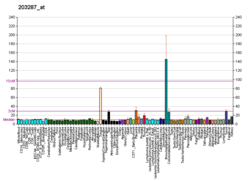References
- 1 2 3 GRCh38: Ensembl release 89: ENSG00000159166 - Ensembl, May 2017
- 1 2 3 GRCm38: Ensembl release 89: ENSMUSG00000041782 - Ensembl, May 2017
- ↑ "Human PubMed Reference:".
- ↑ "Mouse PubMed Reference:".
- ↑ Marinkovich MP, Taylor TB, Keene DR, Burgeson RE, Zone JJ (Jun 1996). "LAD-1, the linear IgA bullous dermatosis autoantigen, is a novel 120-kDa anchoring filament protein synthesized by epidermal cells". J Invest Dermatol. 106 (4): 734–8. doi:10.1111/1523-1747.ep12345782. PMID 8618013.
- ↑ Motoki K, Megahed M, LaForgia S, Uitto J (Apr 1997). "Cloning and chromosomal mapping of mouse ladinin, a novel basement membrane zone component". Genomics. 39 (3): 323–30. doi:10.1006/geno.1996.4507. PMID 9119369.
- 1 2 "Entrez Gene: LAD1 ladinin 1".
Further reading
- Uitto J, Pulkkinen L (1997). "Molecular complexity of the cutaneous basement membrane zone". Mol. Biol. Rep. 23 (1): 35–46. doi:10.1007/BF00357071. PMID 8983017.
- Kim JE, Tannenbaum SR, White FM (2005). "Global phosphoproteome of HT-29 human colon adenocarcinoma cells". J. Proteome Res. 4 (4): 1339–46. doi:10.1021/pr050048h. PMID 16083285.
- Benzinger A, Muster N, Koch HB, et al. (2005). "Targeted proteomic analysis of 14-3-3 sigma, a p53 effector commonly silenced in cancer". Mol. Cell. Proteomics. 4 (6): 785–95. doi:10.1074/mcp.M500021-MCP200. PMID 15778465.
- Strausberg RL, Feingold EA, Grouse LH, et al. (2003). "Generation and initial analysis of more than 15,000 full-length human and mouse cDNA sequences". Proc. Natl. Acad. Sci. U.S.A. 99 (26): 16899–903. doi:10.1073/pnas.242603899. PMC 139241. PMID 12477932.
- Shimizu H, Takizawa Y, Pulkkinen L, et al. (1998). "The 97 kDa linear IgA bullous dermatosis antigen is not expressed in a patient with generalized atrophic benign epidermolysis bullosa with a novel homozygous G258X mutation in COL17A1". J. Invest. Dermatol. 111 (5): 887–92. doi:10.1046/j.1523-1747.1998.00363.x. PMID 9804354.
- Ishiko A, Shimizu H, Masunaga T, et al. (1998). "97 kDa linear IgA bullous dermatosis antigen localizes in the lamina lucida between the NC16A and carboxyl terminal domains of the 180 kDa bullous pemphigoid antigen". J. Invest. Dermatol. 111 (1): 93–6. doi:10.1046/j.1523-1747.1998.00231.x. PMID 9665393.
- Ishiko A, Shimizu H, Masunaga T, et al. (1996). "97-kDa linear IgA bullous dermatosis (LAD) antigen localizes to the lamina lucida of the epidermal basement membrane". J. Invest. Dermatol. 106 (4): 739–43. doi:10.1111/1523-1747.ep12345793. PMID 8618014.





